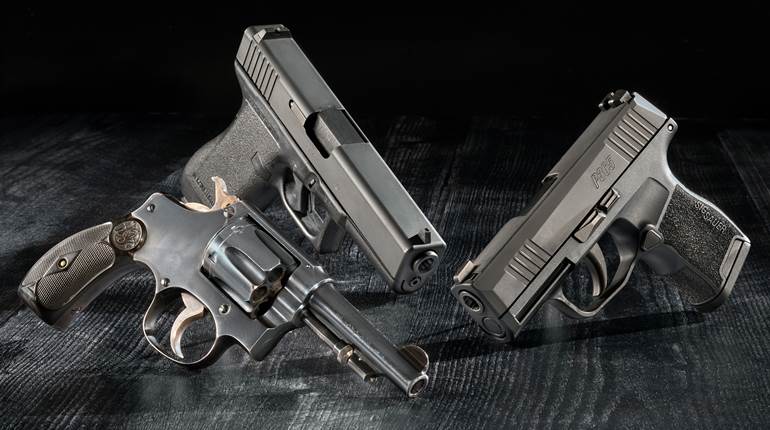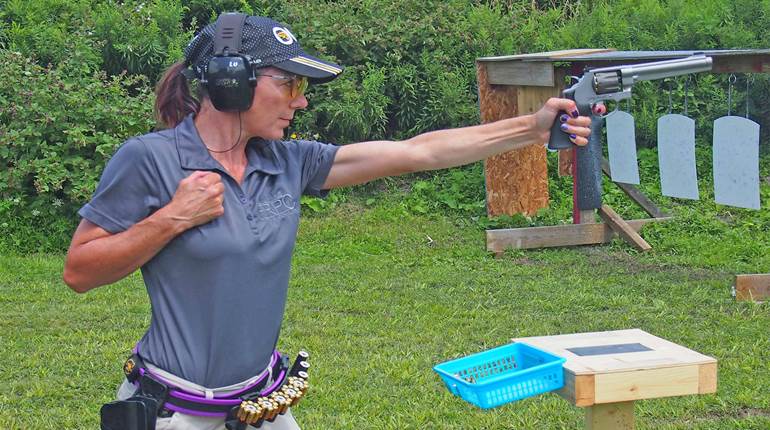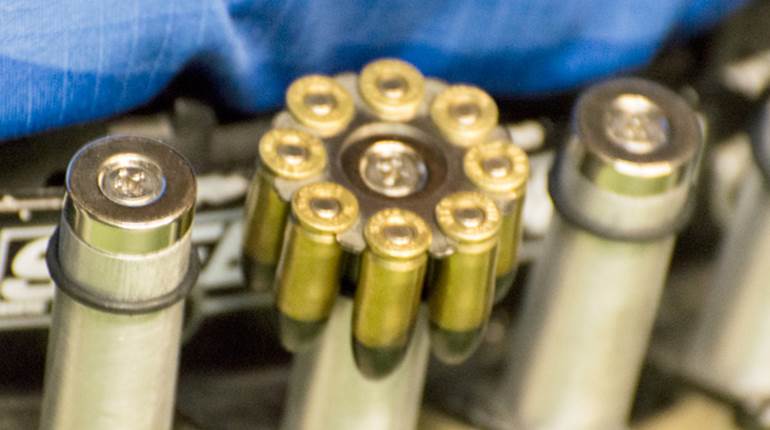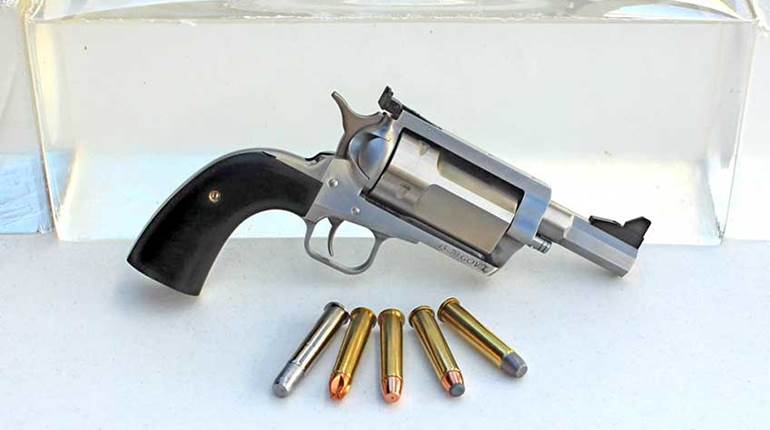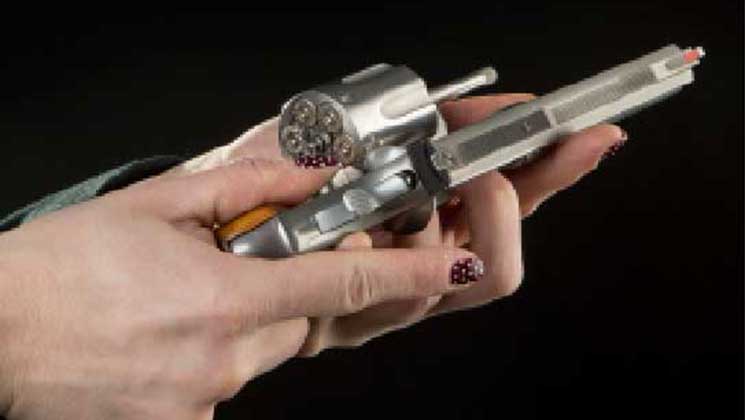
Remember when wheelguns reigned supreme and semi-automatic pistols were largely just for SWAT teams and bullseye shooters? In the 1960s and ’70s, a police officer attracted attention if he was seen carrying a cocked-and-locked M1911 or, later, one of those new ‘Smith’ nines. That was when .38 Spl. brass was gold, and police officers such as Jeff Hoffman of Black Hills Ammunition got their start reloading .38 ammunition in their garages and basements. Colt, Smith & Wesson and, later, Ruger dominated the market. From 2" Chiefs to .357 Mags., the revolver rested in perhaps 90 percent of police holsters, in nightstands and in the hands of shooters on the line at center-fire matches.
But when the switch came to the semi-automatic pistol, it arrived in a rush and, within 10 years, was almost total. Today you seldom see a police officer carrying a revolver. Firepower has replaced tradition, but the wheelgun is by no means dead. Many of those old, almost indestructible, police handguns are now in the hands of civilians who treasure them for home defense, as well as recreational shooting. The sale of revolvers by the major manufacturers is still high, and why not? They are reliable, straightforward in operation and fun to shoot. It’s hard to believe, but there are many in law enforcement and the military who have never fired a revolver. Thirty years ago, FBI recruits were required to shoot 1911s and other pistols for familiarization. Today, revolvers are shot for the same reason.
The revolver is still the ideal handgun for many. If you believe you are outgunned in capacity or power by using the revolver, remember how many varmints—both two- and four-legged—have been taken down with one through the years. For those who haven’t had the opportunity to use a revolver, or who perhaps have forgotten, let’s run through a refresher.
Grip 
Your grip on a revolver should be as firm as possible, and as straight in line with your forearm as can be accomplished considering the size of the frame and your hand. This allows the trigger pull to come straight back into your hand, not torqued to one side. Ideally, for single-action, the pad of the finger should contact the trigger. For double-action, the first joint of the finger is ideal. Revolver stocks are usually narrower at the top so there is a tendency for the hand to “ride up” the frame during firing. To help prevent that, the grips can be oversize to fill the area between the handle and rear of the trigger guard. The Federal Bureau of Investigation issued all its revolvers with grip adapters to fill this area to help keep the hand in place. In addition, on smaller stocks the little finger can be shifted under the grip. That was the reason the FBI issued its old Model 10s with PC (Plain Clothes) stocks. Trigger shoes were not allowed on Bureau handguns, as they prevented a proper double-action pull and could work loose and jam the gun.
Sight Alignment 
How closely the sights are aligned is in direct relationship to the distance to the target and the type of shooting. At room-size ranges, a quick flash of the front sight is all that is required. At longer ranges, careful (and therefore slower) alignment is needed. With the choice of focusing on either the rear sight, front sight or target, the shooter needs to understand the importance of a clearly defined front sight. One old training aid was a block of wood with brass, adjustable front and rear “sights” placed over a bullseye target on an overhead projector. Both the instructor and student could then demonstrate proper sight alignment and picture.
In any case, for double-action shooting, sight alignment is not critical at the start of the trigger pull but rather at the end of the relatively long pull. A careful sight picture before the trigger pull commences can lead to a fast pull, in an attempt to get the shot off before the sights are misaligned.
Trigger Control 
In single-action firing, the hammer is cocked with the thumb, allowing a very short, light trigger pull. This technique was necessary for bullseye shooting and helps greatly in engaging targets at longer ranges. Old-time bullseye shooters sometimes started the pull double-action and then picked up the hammer to cock the gun. Oversize stocks with a thumb rest can aid in single-action shooting but prevent a quick reload, with or without a speedloader. Shooting two-handed allows the shooter to cock the gun with the “off” thumb of the support hand, which is much more efficient than using the thumb of the gun hand.
Double-action shooting requires more care. The long travel of the trigger can lead to jerking shots. The cadence of firing should at least start as a “one-thousand-one” pull with emphasis on a constant pull or even slowing down slightly (but not stopping) at the end, just before the gun fires. The final sight picture is acquired just before firing. Experienced shooters could even shoot the 50-yd. phase of combat courses successfully using this method. If the shooter acquires a perfect sight picture before trigger pull is initiated, a “jerk” is often the result.
“Two-staging” a trigger has the shooter pulling the trigger back rapidly, almost to firing and then stopping to obtain a final sight picture before firing. It could, however, result in an unintentional discharge and is not recommended.
Both dry firing and “ball-and-dummy” exercises—in which live ammunition and dummy rounds, snap caps or empty chambers are alternated—are greatly beneficial to shooters wanting to master double-action technique.
Stance 
Looking at old photos of the FBI’s hip shooting position and its one-armed point shoulder stance, one wonders why it took the Bureau so long to change. The switch to the Weaver position was made after Bill Rogers, a former FBI agent and top firearm instructor, made a visit to Quantico and demonstrated how much more effective it was. Basically, the gun is brought up to eye level. The strong-hand grip is supplemented with the weak hand in a “push–pull” support. The gun arm can be slightly bent at the elbow. This measurably improves the support of the gun and allows more rapid recovery for subsequent shots. Accuracy is much better. In tests at Quantico, nearly every FTU (Firearms Training Unit) instructor fired faster and more accurately at 7 yds. using the Weaver stance compared to the old hip shooting position. And the tests were conducted with shooter and target at the same level. If the target was placed higher or lower than the shooter, hip shooting was even less effective.

When the position was introduced to new agents in training and to in-service personnel, the overwhelming comment was, “Why didn’t you show this to us before?” As an aside, Rogers also convinced FTU to adopt the “rollover prone” position, as well as the “hot line concept,” requiring shooters to reload their revolvers immediately upon emptying, without command. It was the most sweeping change to FBI firearms training in decades. For close-in encounters at arm’s length, the Bureau adopted Bill Jordan’s hip-shooting technique illustrated in the sequence on this page. With it, the gun hand is kept at the belt line, preventing it from being grabbed or deflected by an opponent. The course developed using this technique was shot at 1 and 3 yds.
Reloading
Anyone who believes you can’t reload a revolver quickly hasn’t watched an experienced Police Pistol Combat shooter or Jerry Miculek using full-moon clips. Their speed is amazing. It helps, of course, to have speedloaders. For years, FBI agents loaded from their strong-side pockets during qualifications. They shot five-round strings then. A big step forward was the issue “2x3” bullet pouch that sat on the belt between the holster and buckle. The snap flap was opened with the thumb and tucked, then rounds were loaded two at a time. Then came speedloaders, made by Safariland with the same brand of belt holder for them. With this style of pouch, the rounds straddled the top of the belt, offering more concealment.


A reload consisted of the following steps for a right-handed shooter. Of course, they follow the obvious step of stopping after six rounds (or five for a Chief’s) have been fired. After all, there’s no dry firing in a gun fight!
1. Operate the cylinder latch with the thumb of the right hand and open the cylinder by pushing the two middle fingers of the left hand through the “window.”
2. With the muzzle pointed straight up, push the ejector rod smartly with the thumb of the left hand, and, at the same time, your right hand is heading for spare ammunition.
3. Tilt the muzzle downrange at about a 45 degree angle to the deck and hold the cylinder with the thumb and finger(s) of the left hand to keep it open.
4. With a speedloader, depending on what type, pull it out of the pouch by the outside diameter, align the cartridges with the chambers, push them in until it clicks and then turn it loose. Do not pull the speedloader away from the revolver as that might strip the rounds back out and is an extra, unnecessary step.
5. Allow the speedloader to drop clear as you close the cylinder with the thumb of the left hand, while simultaneously re-gripping the gun with your right. The speedloaders are built to be dropped.
When it comes to loose rounds, load two at a time if possible. Lay the rounds at an angle into the chambers, then rock them in. Rotate the cylinder one-third of a turn counterclockwise with your thumb for each pair to keep the frame from interfering with your reload.
By practicing these techniques, going slowly and deliberately at first and then picking up the pace, you are likely to find that the revolver is a viable option for self-defense. I get at least as much enjoyment from shooting my wheelguns as I do my semi-automatics, and I am constantly reminded of how effective they were—and still are.
Note: The author is a 31-year law-enforcement veteran. The opinions expressed in this article are not necessarily those of the agencies for which he worked. He is the only Special Agent to have fired a “Possible” (perfect score, under specific conditions) for both the FBI and FBI National Academy. He has written several firearm-related articles and manuals for the FBI.












